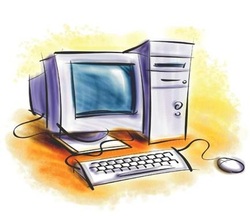Generation of Computer
Generation of Mordern Computer
Computer is one of the marvellous inventions of the recent times. Necessity is the mother of invention. Man always wanted to do some counting or computing. Modern man can count or calculate small numbers with ease, but his requirement for data processing is so enormous that he needs a machine that can instantly process the data captured from source and provide real time response. The early devices such as abacus and slide rule cannot keep pace with his needs. The progress of man from pebbles to Persinal Computer is a great march in technological history of mankind.
The history of computers dates back to the age when man started using tools for computations. The whole history of computing can be divided into two periods based on the technology used in computing devices such as mechanical era and electronic era.
Mechanical Era
Probably the first computing device was the abacus used by the Chinese in the fifth century Be. This was used for systematic calculation of arithmetic operations.
G. W. Leibuitz, a German Mathematician, invented a machine in 1671 that was capable of doing all arithmetic operations.
In 1804 Joseph Marie Jacquard, a French inventor, devised a loom that used punched cards to direct the weaving pattern.
Charles Babbage designed several devices which he called Analytical Engines. In 1822 he designed Difference Engine to calculate life tables (Statistics of expectation of life) for insurance business.
This work led to the development of Analytical Engine, which he designed in 1833. This provided a base for modern computer.
At the end of the 19th century, Herman Hollerith and James Powers designed a data processing machine for processing census data of the USA. Hollerith developed codes for processing both alphabetical and numerical data by punching holes in cards and using a device to read such data into the computer memory.
George Stibitz constructed the first automatic computer at the Bell Telephone Laboratories in New York in 1939. Another major development was the building of MARK-I in 1940s which utilised electro-magnetic relays.
Electronic Era
In the late 1930s John v.Atansoff developed the first electronic computer using valves at Iowa State University. It was a small computer with an add-subtract unit and it employed about 300 valves.
During the period 1946-52, John Von Neumann and his team developed a high-speed digital computer using vacuum tubes called lAS.
Transistor was invented in 1948 at AT&T's Bell Labs. The transistors started replacing vacuum tubes in computers in the 1950s.
Fabrication of integrated circuits was another major development towards the end of 1950s and by the middle of 1960s integrated circuits replaced transistor circuits.
For simplifying and providing a framework for discussion of the growth of computer industry, it is customary to break it into generations of growth. Originally the term 'generation' was used to distinguish between varying hardware technologies. But since 1968, both hardware and software advances are considered in the generations classification. These generations represent major advances in computing technology.
1. First Generation of Computer (1946 - 1954)
2. Second Generation of Computer (1955 - 1964)
3. Third Generation of Computer (1965 - 1974)
4. Fourth Generation of Computer (1975 - 1989)
5. Fifth Generation of Computer (1990 onwards)
